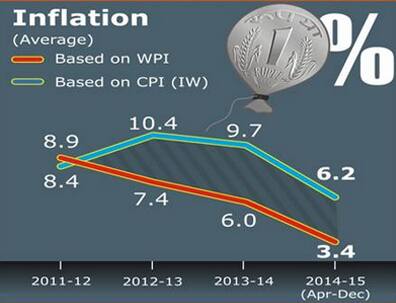India’s consumer inflation will drop to between 5 and 5.5 percent in 2015/16, opening up space for more monetary easing, a finance ministry report said on Friday, a day before the government presents its first full budget. [caption id=“attachment_2125477” align=“alignleft” width=“396”]  Source: PIB[/caption] According to the Economic Survey, Average Wholesale Price Index (WPI) inflation declined to 3.4% in 2014-15 (April-December) as compared to an average of 6% during 2013-14 and even breached the psychological level of 0% in November, 2014 and January, 2015 due to lower food and fuel prices. The retail inflation meanwhile moderated since the second quarter of 2014-15 and declined to an all time low of 5% in the third quarter of 2014-15 after having remained stubbornly sticky at around 9-10% for the last two years. So what led to the fall? Both global factors like persistent decline in crude prices, softness in prices of tradables, particularly edible oils and even coal, and domestic factors like tight monetary policy as well the following government measures to improve availability of food-grains and de-clog the distribution channel. a) Allocation of additional 5 million tonnes of rice to below and above poverty line (BPL and APL) families in the states, pending implementation of the National Food Security Act (NFSA), and allocation of 10 million tonnes of wheat under open market sales for domestic market in 2014-15. b) Moderation in increases in the MSPs during the last and current season; c) Advisory to the states to allow free movement of fruits and vegetables by delisting them from the Agricultural Produce Marketing Committee (APMC) Act; d) Bringing onions and potatoes under the purview of the Essential Commodities Act 1955, thereby allowing state Governments to impose stock limits to deal with cartelization and hoarding, and making violation of stock limits a non-bailable offence; e) Imposing a minimum export price (MEP) of U$ 450 per million tonne for potatoes with effect from 26 June, 2014 and US$ 300 per MT for onions with effect from 21 August, 2014.
India’s consumer inflation will drop to between 5 and 5.5 percent in 2015/16, opening up space for more monetary easing, a finance ministry report said on Friday, a day before the government presents its first full budget.
Advertisement
End of Article


)
)
)
)
)
)
)
)
)



